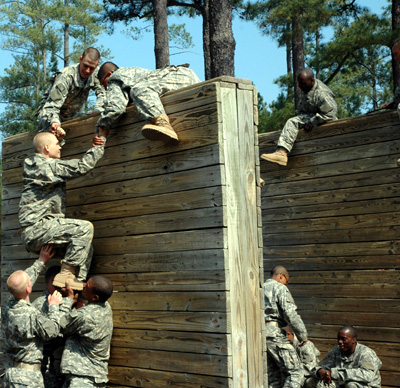Introduction
Obstacle courses, formerly known as assault courses, are a very effective form of training for military personnel and have been used by UK military forces for at least 100 years.
Traditionally, assault courses would entail a number of obstacles placed in a straight line and soldiers, divided into two teams, would then compete against each other to achieve the fastest time.
In contemporary times the assault course has evolved into a sophisticated training modality, with a change in name and emphasis. Training packages such as FIBUA (fighting in built up areas) and OBUA (obstacles in built up areas) were developed to enable realistic training to prepare military personnel for the environments they were likely to encounter.
This approach not only develops teamwork and mental and physical training attributes but also situational awareness and close quarter battle (CQB) techniques.
In contrast to military commanders who have been striving for more realistic training environments, commercial organisers in the outdoor fitness market have been developing ever more outlandish, fiendish, fun and sophisticated obstacle courses for the dual role of pain and pleasure for their clients.
Please view the ‘Mud & Weighted Run Events & Races’ sub-section of the website for more information on providers.
Types of Obstacle Course
Within the military environment there are two main types of obstacle course you may come across and these include:
- Synopsis:
- Type A: Garrison course that has 16 obstacles.
- Type B: Trained soldiers’ course that has 12 obstacles.
- Type C: Recruit soldiers’ course that has 10 obstacles.
- Non-synopsis:
- Confidence courses.
- Adventure/Trim ditch courses.
- Aerial rope way slides.
For commercial organisers obstacle courses can range from a mix of well developed semi-permanent structures with familiar obstacles to one-off special events.
Trainasium Training
There are three levels of obstacles to cross during trainasium training consisting of:
- Level 1: Plank balance, Burma Bridge, Shuffle bars, Grilled platforms and Fireman’s poles
- Level 2: Scaffold ladders, Grilled platforms and Fireman’s poles
- Level 3: Scaffold ladders, Grilled platforms, High shuffle bars and Aerial slides.
Dress Code
The dress code for obstacle training/events in a military environment should be:
- Long sleeve jacket (e.g. combat jacket);
- Long trousers (e.g. combat trousers);
- Combat boots;
- Helmet; and
- No jewellery (e.g. rings or watches).
Dress standards for commercial organisers will vary depending upon the type and nature of the obstacle course to be used. Typically, t-shirt, shorts and trainers are the staple diet with a recommended change of, ‘warm’, clothing after completion.
Effective Obstacle Crossing
Within the military environment, to achieve effective obstacle crossing the following must be carried out:
- Maximum degree of safety;
- Economy of effort;
- Speed and silence; and
- Reaching objective in a ��Fit to Fight’ condition.
In contrast, in a commercial environment organisers will most likely construct and/or select obstacles which are inversely related to points 2 to 4 above; i.e. make obstacle crossing as difficult as possible whilst still being safe.
Technique and Progression
The following techniques are carried out on obstacle courses:
- Balancing;
- Jumping and landing;
- Groundwork;
- Climbing and scaling;
- Team work; and
- Confidence training.
Physiological and Psychological Benefits
There are two main areas that obstacle course training can improve and these include:
- Physical:
- Strength.
- Speed.
- Stamina.
- Agility.
- Mental:
- Self-confidence.
- Initiative.
- Team spirit.
- Self-confidence.
Maintenance
Maintenance is extremely important with regards to health and safety (H&S). Within the military environment all obstacle courses are the Unit’s responsibility and within a commercial environment responsibility lies with the owner. However, organisation’s sponsoring events (where an obstacle course is hired on a contractual basis) still have a duty of care to their clients for H&S on the obstacle course.
Obstacles that are defective should be clearly marked out of bounds and reported to the appropriate authority. If necessary, a course marshal should be positioned at the obstacle to ensure there is no inadvertent use of the obstacle.
Safety
Safety should be considered at all times and the following adhered to:
- The maximum student/client to staff ratio should not exceed 15 to 1.
- Maintain audible and visual contact with students/clients at all times.
- First aid cover should be available.
- Safety vehicles are available where necessary.
- Check all obstacles before commencing training or the event.
- Report any faults to the appropriate authority.
Safety Checks
The instructor/organiser should check for the following prior to training/the event:
- All landing areas are free from obstruction.
- All walkways are not slippery.
- Scaffold frames are dry and free from frost.
- All couplings are visually checked and tested periodically.
- Ropes are tested and fray free.
- For training above level one (see Trainasium Training), only one person shall be permitted to carry out a task at any one time.
- The supervisor/organiser should suspend training/events in the event of bad weather or undue risk to the students/clients.
Accident Prevention
Accidents can be prevented as long as the following instructions are carried out:
- Safety precautions are carried out.
- Sound techniques are used to cross the obstacles.
- Training sessions are progressive.
- Consideration is given to the environmental conditions.
- Standing-in procedures are developed.
- Participants are warmed up before and cooled down after sessions.
First Aid Cover
The minimum first aid cover required is:
- Safety vehicle.
- First aid pack available.
- Stretcher available.
- A first aid qualified person is present.
During larger events an on-site ambulance and medical team may be required. Local requirements may vary between Local Authorities.
Related Articles
- Themed Runs, Obstacle Courses Taking Over Jogging Events (blogs.laweekly.com)
- Obstacle Racing 2013: The Complete Guide (outsideonline.com)
- Ideas To Create The Best Obstacle Course Races (robertlivingston867.wordpress.com)


One thought on “Obstacle Courses: Overview”